Last Updated on 23rd December 2019 by Sarah and Justin
Do you enjoy behemoth statues, brutalist architecture, and burek? If yes, Skopje is the destination for you. We had a blast on our recent trip to the capital of North Macedonia (aka the capital of kitsch) and are excited to share our recommendations for things to do in Skopje.
There’s a lot of great Skopje sightseeing to do: a gazillion statues, churches and mosques, a fortress. And there’s so much to learn about the city from different cultural, historical, and culinary perspectives. We organized this post into sections to help you sort through what to do in Skopje. It’s a long one, so feel free to skip ahead to the section that interests you most.
A brief introduction to Skopje
Skopje is the capital of what is now called North Macedonia (we were actually visiting during the final negotiations with Greece). It’s located in the north and is the biggest city in the country. Skopje has a long and interesting history, but most of what you’ll see is much more recent, erected as part of the controversial Skopje 2014 project. The project was undertaken to restore and modernize the city’s infrastructure and also make it a more appealing tourist destination. But it ended up being riddled with corruption and excessive spending on monuments of questionable artistic value.
We completely understand why the project caused such controversy and wasn’t so positively received by many of the people living in the city. But we really enjoyed our visit to Skopje, not only because of, but definitely including, all those weird and wacky statues.
Things to do in Skopje: the statues
Monumental statues
Whatever you’ve heard or read about the Skopje statues, you cannot be prepared for what you’ll actually see in person. There are so many of them lining buildings and bridges and just plopped in the middle of streets. Some of them are a relatively standard size. But then there are these absolutely enormous statues that dwarf everything else around them. Here are the most notable and our favorites.
Warrior on a Horse
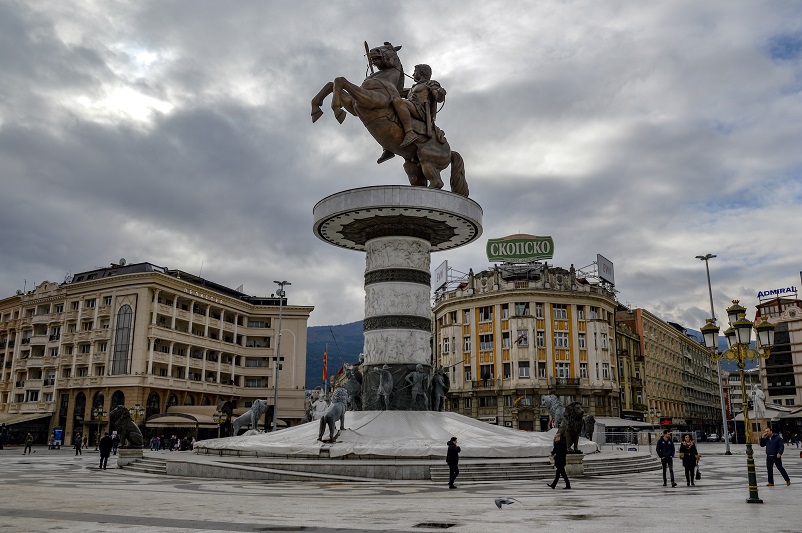
The most famous and controversial is the statue known as the “Warrior on a Horse.” He’s really Alexander the Great, but don’t tell that to Greece. He’s enormous, at 22 meters high. He’s flanked by lions and soldiers guarding him. And like many of the monuments in Skopje, his base is also a fountain (it was covered when we visited in January).
Philip II and Olympias monuments
Though we enjoyed looking up at Alexander every time we passed through the main square, he wasn’t our favorite monumental statue in Skopje. That honor goes to a pair of monuments standing across the Stone Bridge. A gigantic Philip II, Alexander’s father, stands with his fist raised atop an also enormous pedestal. Protective warriors stand at the level beneath him. And at the base are women, children, and lions. Across from Philip is another sculptural behemoth. Known as the Olympias monument, this collection of statues shows women in various stages of pregnancy and motherhood. It is bizarre and amazing and Sarah couldn’t take enough pictures.

Justinian I

Another statue that Sarah couldn’t resist photographing every time we walked by it is that of Justinian I, the Roman emperor. Built in white marble, it looks as if the emperor is guarding the Vardar River.
Lions
Four lions guard the Goce Delcev bridge. Two are in a more traditional style. Two are more modern. All four of them are enormous. Look at the size of these lions! This bridge is a tiny bit outside the center of the city, but close to some other attractions like the Kale Fortress and offers some nice views too.
The Bridge of Civilizations and the Art Bridge
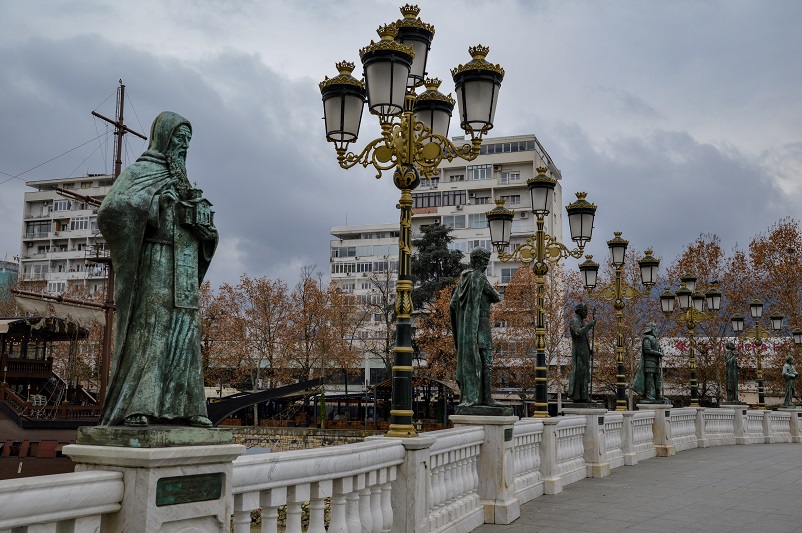
There are two pedestrian bridges in Skopje lined with even more statues. The Bridge of Civilizations features figures from history and legend including kings and priests and warriors. This bridge leads to the Archaeological Museum of Macedonia, another relatively new addition to the city. The Art Bridge features artistic figures including artists and writers and composers. It leads to the collection of buildings housing the philharmonic, opera, and ballet.
Sure these bridges are a bit odd, but we actually really enjoyed walking over them and looking at the statues and learning about these figures.
Whimsical and wacky statues

There are a whole bunch of other seemingly random statues around Skopje as well. If it were any other city without a thing for statues, you might just take note of them and not give them a second thought. But in this city, they make you think things like: “why is there a copy of the Wall Street Bull statue in Macedonia?” Some are fun and whimsical, like the musicians above. All of them just make you wonder if there was any larger goal to this project or just a bunch of different people wanting to decorate the streets according to their own aesthetics.
Skopje attractions: history and culture
The Stone Bridge
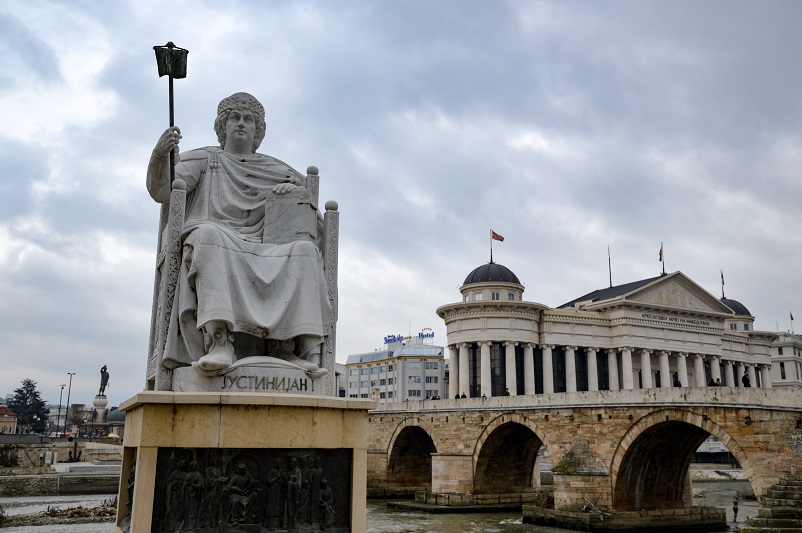
The Stone Bridge is one of the major symbols of Skopje, even appearing on the city’s coat of arms and flag. It is much older than the other pedestrian bridges nearby, and is not covered in statues. The bridge was most likely built during the 15th century (although some think it was first built centuries earlier). It is an important landmark, connecting the two main parts of the city separated by the Vardar River, which are now especially striking in their contrasts. Most visitors will start off at Macedonia Square and cross over into the Old Bazaar.
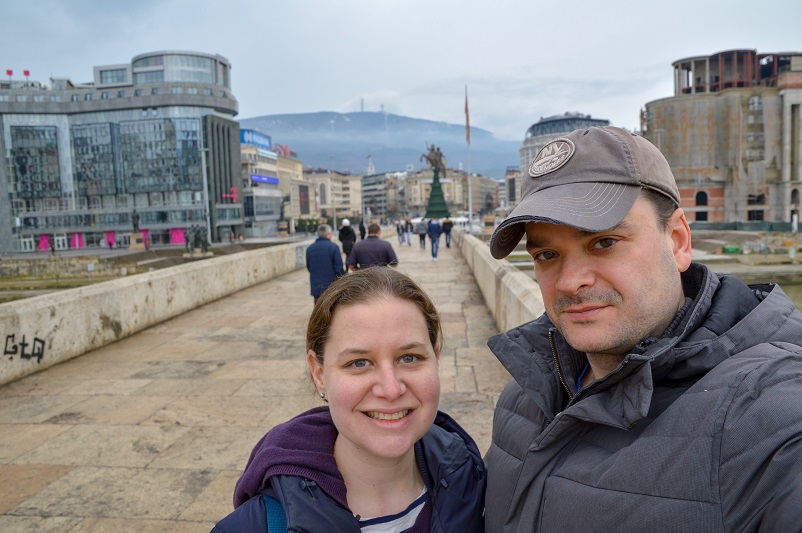
Old Bazaar Skopje
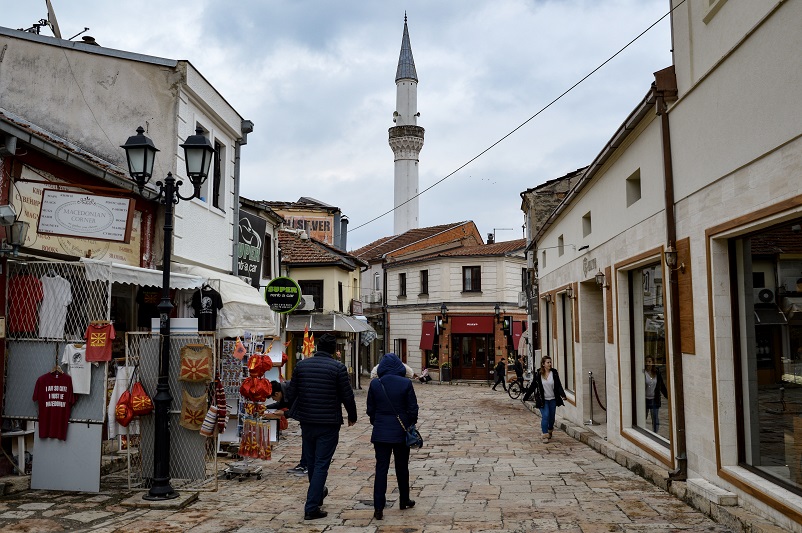
The Old Bazaar in Skopje is like the city’s Old Town. It’s a collection of cobblestone streets with small buildings that is in sharp contrast to what you’ll see on the other side of the Vardar River in and around Macedonia Square. Some of the area admittedly seems a bit touristy, what with every other storefront selling souvenirs. But if you venture further and get a bit lost in its winding streets, you’ll see locals sitting down for tea or enjoying burek or heading to one of the areas mosques.
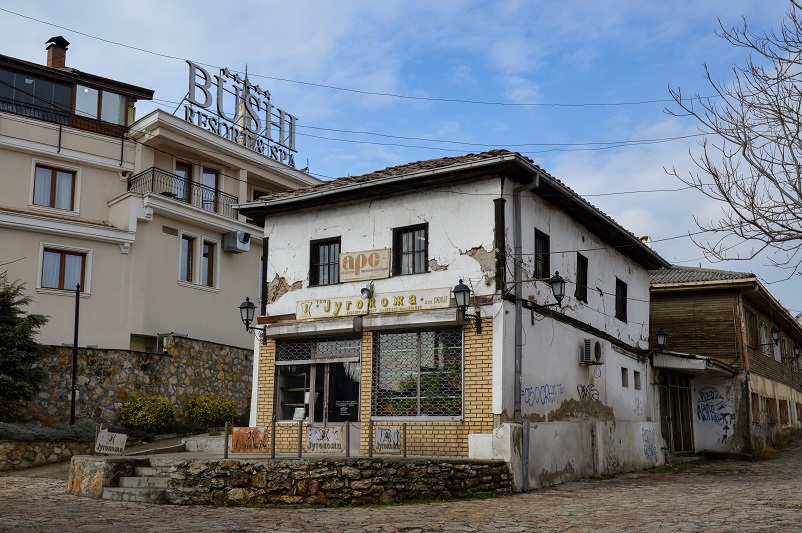
We didn’t have time to really explore the area until our third day in Skopje. So the contrast of seeing these old streets with real stores and real people (and no statues!) was even more great. Getting lost in the Old Bazaar is fun (and it’s so small you can’t get too lost), but there are a few points of interest that you should keep an eye out for.
Just across the Stone Bridge, next to the massive statue of Philip II, is the small Church of St. Demetrius, which is worth peeking inside. Mustafa Pasha’s Mosque from the 15th century is a bit uphill but worth the climb. If you like woodcarvings, head to the Church of the Ascension of Jesus. To see some contemporary art in a not so contemporary setting, visit the National Gallery in the Chifte Hamam. The Museum of Macedonia has an interesting courtyard (pictured below) with statues and ruins that’s worth visiting even if you don’t go inside the museum (we didn’t). And of course, there’s the market, which we talk about in the section about Macedonian food below.

Skopje Fortress
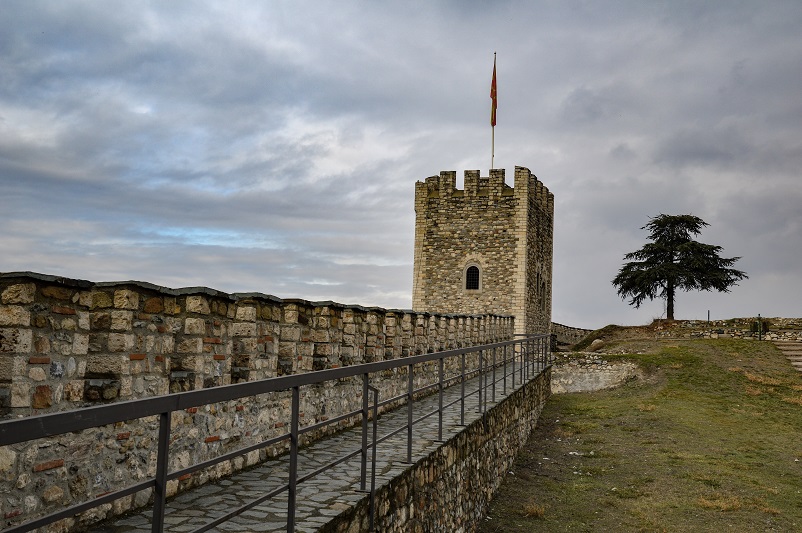
The Skopje Fortress (also known as the Kale Fortress, although “kale” is the Turkish word for “fortress” so that’s a bit redundant!), is another major symbol of the city. Like the Stone Bridge, it also appears on Skopje’s coat of arms and flag. In researching the fortress, we read a lot of reviews that it wasn’t worth visiting. We’re not sure why. There are ruins to see, walls to walk on, and sweeping views of Skopje to admire.
The history of the place is a bit dodgy, but based on archaeological finds, people believe the earliest inhabitants of the area date back to the Neolithic and Bronze Ages. Important artifacts from the Byzantine Empire have also been found on the hill.

You can get to the fortress from the Old Bazaar, but we opted to approach it a different way. We walked across the aforementioned Goce Delcev bridge (the one with all the lions) and meandered up a long, but not too steep hill. The fortress is free to enter, but there may be guides trying to sell you their services at the gate. Atop the hill is a wall with a few towers. We walked along most of the wall, some of which is steep and requires climbing steps, and admired the views of the city below and beyond.
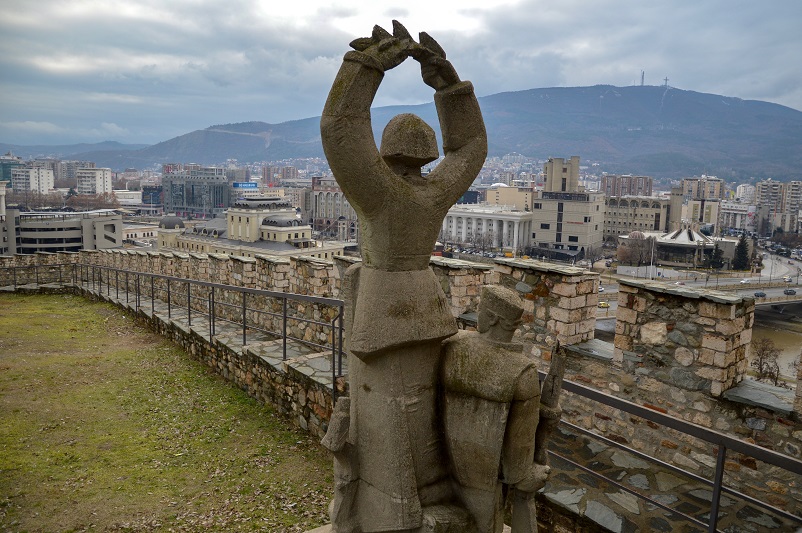
The Museum of the City of Skopje
Much of Skopje was destroyed in an earthquake in July 1963. The old railway station was one of the buildings that suffered major destruction, but it was partially reconstructed and is now home to the city’s museum. Approaching the building, you’ll first note the exterior clock, frozen at 5:17 – a constant reminder of the time the earthquake struck. You’ll then notice that half the building is missing.
The museum itself is small, but has interesting and varied exhibitions. There are permanent exhibitions including one of archaeological finds from the region and one about the earthquake. The museum also showcases art in temporary exhibitions. During our visit, we saw a showcase from the international print biennale. It’s free and the people who work there are very nice and informative.
The Memorial House of Mother Teresa
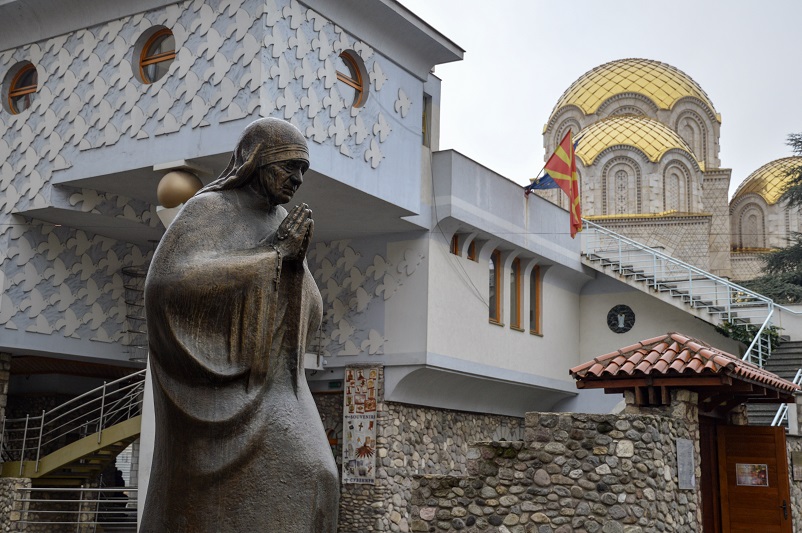
Mother Teresa was born in Skopje. In 2009, a memorial house and museum was opened in her honor. It is located on the spot where the church in which she was baptized stood. As you’d expect in Skopje, you’ll find statues of Mother Teresa there. The building itself is interesting, but a bit confusing with its mix of styles and materials. We explored the exterior and the inner courtyard but opted not to visit the museum itself.

Skopje sightseeing: the architecture

As part of the Skopje 2014 project, many of the city’s major buildings and facades were rebuilt in the classical style (as you can see in the above the picture of the Archaeological Museum). But to us, the much more interesting buildings were those built in completely different styles.
The post office

A standout of brutalist architecture is the post office. We actually just stumbled upon this massive, bizarre structure and had to get a closer look. It’s right at the end of the Goce Delcev bridge, just a few minutes walk from Macedonia Square.

Makedonski Telekom building
We thought another really interesting building in Skopje was the building at one corner of Macedonia Square: the headquarters of Makedonski Telekom (as you can tell from its signage). It reminded us of something that might be found in the Capitol in the Hunger Games.
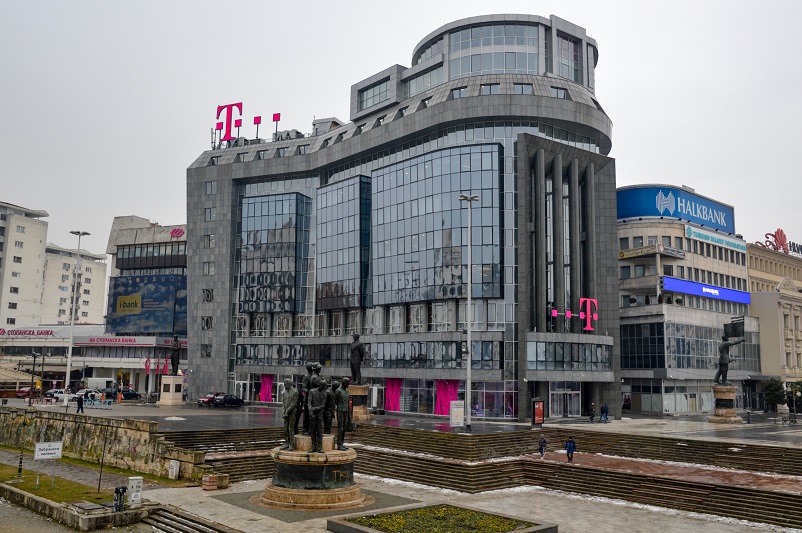
Church of Saint Clement of Ohrid

About ten minutes from Macedonia Square is Church of Saint Clement of Ohrid, an Eastern Orthodox church built between 1972-1990. It is quite the interesting structure, with enormous grey domes, brick walls, and a detached tower. Inside, the ceilings are decorated with the most brightly colored murals. We’d definitely recommend a visit both inside and out.
Macedonian food in Skopje
We were blown away by the food in Skopje. Many of the dishes and flavor combinations were new to us and unique, but the ingredients were familiar with staples like paprika, peppers, eggplant, yogurt, and cheese. That made us comfortable trying and tasting new things.
Burek in Skopje
We’ve now visited three cities in three different countries in the Balkan region. Burek, a heavy and filling baked good made primarily of phyllo dough, is a staple of this region and we now wish it could be a staple of our diet all the time (although our waistlines are glad that’s not possible). The two most common varieties are cheese and meat, although we’ve enjoyed burek with spinach and other vegetables as well.
We tasted burek at too many a few different places and can confidently recommend our favorite. A&M is a small, somewhat obscure bakery right off Macedonia Square. It’s tucked in a corner of the street leading off the square into the shopping center. Each (massive) piece cost 100 MKD. The dough had the most distinct and delectable sourdough taste.
Note, the burek in the Old Bazaar is cheaper than that in modern center across the Stone Bridge. As we were heading to the airport we couldn’t resist one last taste and purchased some at a small shop there for 50 MKD per piece.
The Bit Pazar
The Bit Pazar is a large outdoor covered market in Skopje’s Old Bazaar. As most markets are, it’s a great place to experience the local flavors (literally and figuratively) of the city. We meandered through the narrow walkways checking out everything on offer. We were specifically looking for paprika, and weren’t disappointed. We found a stall with bright red piles of the spice in varying levels of heat and sweetness. The proprietor did speak a little English, so we were able to confirm which was the spiciest (for Justin) and one that was a bit sweeter (for Sarah).
If you’re staying in Skopje longer or want to cook for yourself, you can easily buy all your provisions there. Most of the people we encountered in the market didn’t speak any English, so if you go, be prepared to communicate with hands and smiles.
Skopje restaurants
Though we honestly could have subsisted on burek alone, we did have some great sit down meals. Here are our favorite Skopje restaurants.
Old City House

We enjoyed a really tasty and hearty dinner at Old City House. It’s on the same side as the Old Bazaar, but on a bigger street outside the winding cobbled alleys. It’s quite a big restaurant with quite a big menu, so you can try all the Macedonian specialties. We feasted on ajvar (a red pepper dip), tavce gravce (baked white beans), and stewed meats.
Palas in the Old Bazaar
On the main street leading to the Bit Pazar in the Old Bazaar are numerous small shops selling tavce gravce and cevapi (small sausages). We eyed one that looked especially tasty and that didn’t have an English menu out front and had lunch. The kitchen in these small shops is actually a small box in the window that has a big exhaust pipe at the top to release the smoke from the grill. We ordered by saying simply the items we wanted (tavce gravce and cevapi!) and dug in. Both are served with fluffy bread, spicy paprika, onions, and vinegar. Everything was delicious, and the owners who made and served our food were extremely kind. We wish we’d had time to return for another bowl of beans.
Craft Brewery Temov: Pivnica Star Grad

The first Macedonian craft brewery is in Skopje, so of course we went! There are now two locations of Craft Brewery Temov: one in the Old Bazaar and one in Macedonian Square (called Kolektiv). We went to the one in the Old Bazaar. We got the tasting flight because we wanted to try as many of their beers as possible, but this is not the most economical choice. And our favorite beer ended up being their standard pilsner. For food, we ordered their tasting platter of beer snacks, which was outstanding. We ate a whole variety of different spreads and though we didn’t know what any of them were, we loved them all.
Accessibility in Skopje
Skopje is a city of contrasts, and that goes for accessibility as well. The more modern half of the city around Macedonia square is newly developed and well-kept. Although Macedonia Square can get extremely slippy during rain and snow. The Old Bazaar is a bit more difficult to navigate, with crumbling sidewalks, dodgy ramps, and cobblestones. We didn’t take any public transportation in Skopje, so can’t comment on its accessibility.
Skopje air quality
We realized we made one error in planning our trip to Skopje. We visited in January and learned, when we were there, that the city has terrible air pollution and that it’s especially bad during winter. We were actually there just a couple days after the city earned the honor of most polluted city in the world. Clearly this was disheartening given Sarah’s lung disease. While we didn’t feel anything walking around, Sarah definitely tired more easily. And we opted not to do certain things because of it. If you have a lung condition or breathing problems, Skopje may not be the city for you.
Skopje hotels

We stayed at the Hotel London B&B. It was in a great location right off Macedonia Square, but quiet. It was quite reasonably priced at 105 EUR for three nights including breakfast. Note, the rooms are up two flights of stairs.
<< Book your stay at Hotel London B&B or somewhere else in Skopje >>


















I’m really interested in the Balkan region atm. Planning on going to Albania this summer. I’ve heard about the pollutions in Skopje so that’s a bit off-putting, to be honest. Oh, by the way, how would a vegetarian fare in Macedonia in your opinion, good, terrible?
We are very interested in seeing more of the region as well. We just went to Serbia and had a great time. There were actually a lot of veggie options on menus in Macedonia and our favorite foods didn’t have meats. And one of the staples is a chopped salad. If you eat cheese and yogurt, those are great. However, we’d be mindful/questioning of what things are cooked in. Eg, pretty sure some all veggie dishes might be cooked in pork fat. You should just learn/write the word for that and ask!
Think this is the most in-depth post I’ve read about Skopje (though admittedly I haven’t read many others!). Also since the name change I’ve been reading more about the country in general… so I’m now very interested and intrigued
Thanks for the awesome compliment! We wish we’d had more time on this trip to see more of the country. Definitely interested in returning.
I’ll probably never be able to get there myself, but your lovely photos made it so I could at least get a taste of what it would be like! It’s always fun to read about somewhere that’s a bit more unusual than the usual suspects that every traveler visits and writes about 🙂
Well, it seems like you have covered almost everything. The 2 main things missing out are the Millenium cross on the top of Vodno mountain and Canyon Matka. If you haven’t already visited them, next time they should be on your list.